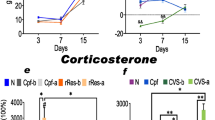Summary
In the Djungarian hamster seasonal acclimatization is primarily controlled by photoperiod, but exposure to low ambient temperature amplifies the intensity and duration of short day-induced winter adaptations. The aim of this study was to test, whether the pineal gland is involved in integrating both environmental cues. Exposure of hamsters to cold (0 °C) reduces the sensitivity of the pineal gland to light at night and prevents inactivation of N-acetyltransferase (NAT). The parallel time course of NAT activity and plasma norepinephrine content suggests that circulating catecholamines may stimulate melatonin synthesis under cold load.
Similar content being viewed by others
Abbreviations
- NAT :
-
N-acetyltransferase
- NE:
-
norepinephrine
- T a :
-
ambient temperature
References
Anton AM, Sayre DF (1962) A study of the factors affecting the aluminium oxide-trihydroxyindole procedure for the analysis of catecholamines. J Pharmacol Exp Ther 138:360–375
Axelrod J (1974) The pineal gland: A neurochemical transducer. Science 184:1341–1348
Blank JL, Desjardins C (1985) Differential effects of food restriction on pituitary testicular function in mice. Am J Physiol 248:R181-R189
Brainard GC, Richardson BA, Hurlbut EC, Steinlechner S, Matthews SA, Reiter RJ (1984) The influence of various irradiances of artificial light, twilight and moonlight on the suppression of pineal melatonin content in the Syrian hamster. J Pineal Res 1:105–119
Bucana CD, Nadakavukaren MJ, Frehn JL (1973) Ultrastructural features of the pineal gland from cold-exposed golden hamsters. J Neurocytol 2:237–247
Deguchi T, Axelrod J (1972a) Control of circadian change of serotonin N-acetyltransferase by the β-adrenergic receptor. Proc Natl Acad Sci USA 69:2547–2550
Deguchi T, Axelrod J (1972b) Sensitive assay for serotonin N-acetyltransferase in the rat pineal gland. Anal Biochem 50:174–179
Desjardins C, Lopez MJ (1980) Sensory and nonsensory modulation of testis function. In: Steinberger A, Steinberger E (eds) Testicular development, structure and function. Raven Press, New York, pp 381–388
Heldmaier G, Steinlechner S (1981a) Seasonal pattern and energetics of short daily torpor in the Djungarian hamster, Phodopus sungorus. Oecologia 48:265–270
Heldmaier G, Steinlechner S (1981b) Seasonal control of energy requirements for thermoregulation in the Djungarian hamster (Phodopus sungorus), living in natural photoperiod. J Comp Physiol 142:429–437
Hoffmann K (1973) The influence of photoperiod and melatonin on testis size, body weight, and pelage colour in the Djungarian hamster (Phodopus sungorus). J Comp Physiol 85:267–282
Hoffmann K (1979) Photoperiodic effects in the Djungarian hamster: one minute of light during darkness mimics influence of long photoperiods on testicular recrudescence, body weight and pelage colour. Experientia 35:1529–1530
Illnerová H, Vanecek J (1979) Response of rat pineal serotonin N-acetyltransferase to one minute light pulse at different night times. Brain Res 167:431–434
Illnerová H, Vanecek J, Krecek J, Wetterberg L, Sääf J (1979) Effect of one minute exposure to light at night on rat pineal serotonin N-acetyltransferase and melatonin. J Neurochem 32:673–675
Lynch HJ, Eng JP, Wurtman RJ (1973) Control of pineal indole biosynthesis by changes in sympathetic tone caused by factors other than environmental lighting. Proc Natl Acad Sci USA 70:1704–1707
Parfitt AG, Klein DC (1976) Sympathetic nerve endings in the pineal gland protect against acute stress-induced increase in N-acetyltransferase (EC 2.3.1.5) activity. Endocrinology 99:840–851
Pevet P, Vivien-Roels B, Bonn D (1986) Effect of temperature on the gonadal atrophy induced by short photoperiod in the golden hamster. In: Assenmacher J, Boissin J (eds) Endocrine regulations as adaptive mechanism to the environment. CNRS, Paris, pp 201–206
Reiter RJ (1981) The mammalian pineal gland: structure and function. Am J Anat 162:287–313
Seggie J, Campbell L, Brown GM, Grotal J (1985) Melatonin and N-acetylserotonin stress responses: effects of type of stimulation and housing conditions. J Pineal Res 2:39–49
Steinlechner S, Champney TH, Houston ML, Reiter RJ (1984) Simultaneous determination of N-acetyltransferase activity, hydroxyindole-O-methyl-transferase activity, and melatonin content in the pineal gland of the Syrian hamster. Proc Soc Exp Biol Med 175:93–97
Steinlechner S, King TS, Champney TH, Richardson BA, Reiter RJ (1985) Pharmacological studies on the regulation of N-acetyltransferase activity and melatonin content of the pineal gland of the Syrian hamster. J Pineal Res 2:109–119
Steinlechner S, Stieglitz A, Ruf T, Heldmaier G, Reiter RJ (1991) Integration of environmental signals by the pineal gland and its significance for seasonality in small mammals. In: Fraschini F, Reiter RJ (eds) Role of melatonin and pineal peptides in neuroimmunomodulation. Plenum, New York (in press)
Tannenbaum MG, Reiter RJ, Vaughan MK, Troiani ME, Gonzalez-Brito A (1988) Effects of short-term cold exposure on pineal biosynthetic function in rats. Cryobiology 25:227–232
Urry RL, Dougherty KA, Frehn JL, Ellis LC (1976) Factors other than light affecting the pineal gland: hypophysectomy testosterone, dihydrotestosterone, estradiol, cryptorchidism, and stress. Am Zool 16:79–91
Vaughan GM, Allen JP, Tullis W, Sackman JW, Vaughan MK (1978) Stress-induced increase of pineal N-acetyltransferase activity in intact rats. Neurosci Lett 9:83–87
Welker HA, Vollrath L (1984) The effects of a number of shortterm exogenous stimuli on pineal serotonin N-acetyltransferase activity in rats. J Neural Transm 59:69–80
Wurtmann RJ, Axelrod J, Fischer JE (1965) Melatonin synthesis in the pineal gland: Effect of light mediated by the sympathetic nervous system. Endocrinology 75:226–272
Author information
Authors and Affiliations
Rights and permissions
About this article
Cite this article
Stieglitz, A., Steinlechner, S., Ruf, T. et al. Cold prevents the light induced inactivation of pineal N-acetyltransferase in the Djungarian hamster, Phodopus sungorus . J Comp Physiol A 168, 599–603 (1991). https://doi.org/10.1007/BF00215082
Accepted:
Issue Date:
DOI: https://doi.org/10.1007/BF00215082




